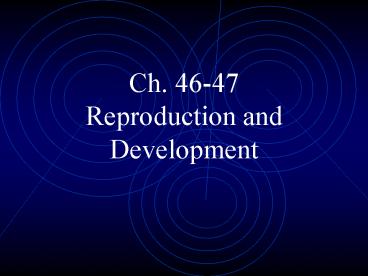Ch. 46-47 Reproduction and Development - PowerPoint PPT Presentation
1 / 30
Title:
Ch. 46-47 Reproduction and Development
Description:
Ch. 46-47 Reproduction and Development Sexual vs Asexual Reproduction Under what circumstances would each be an advantage? When would each be a disadvantage? – PowerPoint PPT presentation
Number of Views:44
Avg rating:3.0/5.0
Title: Ch. 46-47 Reproduction and Development
1
Ch. 46-47 Reproduction and Development
2
Sexual vs Asexual Reproduction
- Under what circumstances would each be an
advantage? - When would each be a disadvantage?
- Hermaphroditic sequential hermaphroditic
- Sessile, burrowing, parasitic
- Parthenogenesis (egg production w/out ____ )
3
- Maori Wrasse protogynous, protandrous
4
- External fertilization
- Fertilization happens in the environment
- Usually needs moisture
- Needs environmental cues Timing, location,
pheromones etc. - Internal fertilization
- Copulation, usually fewer eggs, but more
protection of embryos (iteroparity) - (see Ch 52, table 52.3, and fig 52.4 other
figures) - Page 1089 semelparity (r) vs iteroparity (K)
- R and K selected populations -- see p.
5
- Male forms of birth control
- About how long can human sperm last in the female
body? - Each meiotic division cycle makes __sperm.
- Do men have an equivalent to menopause?
Spermatogenesis
6
Semen components Sperm from? Sugars
mucus, alkaline fluid from? Citrate nutrient
(acidic) from ? Neutralizer from?
Acrosome
7
Oogenesis
- Menstrual cycle vs. estrous (heat)
- Forms of female birth control?
- What are fertility drugs?
- How many eggs are produced for each meiotic
cycle? - What is menopause? (cause?)
8
- Study the phases and the hormones at each phase
- GnRH
- LH
- FSH
- HCG
- Progesterone
- Estrogen
- Testosterone
9
Fertilization, Cleavage, Implantation what,
where, when how?
10
Acrosomal and Cortical Reactions(Fast-block and
Slow-block to polyspermy)
11
- Blastocyst implantation
- Trophoblast becomes the
- Embryonic placenta
- VIDEO
12
Placental barrier What crosses to and from
the fetus? What
cannot cross? WHY?
13
Ecology terms and figures to look up
- Mostly from ch 51, 52
- P. 1070 1075
- Cohort
- Survivorship curves, types I, II, III
- Fig 52.4, 52.8, 52.10
- 52.5 (r and K)
- Semelparity
- Iteroparity
- Population
- Table 52.3
- Carrying capacity
- Figs. 52.20, 52.21
- What is fecundity
- Density dependent factors
- Density independent factors (examples?)
- Biomagnification and oestrogens (from chapter 54)
p. 1147
14
Environmental estrogens
- Endocrine-disruptors
- Endocrine-modulators
- Ecoestrogens
- Environmental hormones
- Xenoestrogens
- Hormone-related toxicants
- Endocrine-active compounds
- Phytoestrogens
15
DDT Dichlorodiphenyltrichloroethane
- Biomagnification or Bioaccumulation
16
(No Transcript)
17
- Urchin Gastrulation
- ( proto or deutero-stome ? )
- Triploblastic (know 3 layers)
- Archenteron
- Organogenesistrimesters
18
Table 47.1 GERM LAYER p. 945 Organs and tissues formed
ECTODERM Skin, cornea and lens of eye, nervous system (neural tube), mouth and rectum
ENDODERM Digestive tract lining, respiratory system lining, many organs
MESODERM Notochord, skeleton, muscles, circulatory systems, reproductive system, excretory system
19
- Nerve cord? Notochord?
- Primitive streak
- What structure(s) does each layer give rise to?
- Organogenesis (differentiation) happens very early
20
(No Transcript)
21
Spina bifida
22
Thalidomide (mutagen) caused horrific birth
defects in the 1960s, when pregnant women in 48
countries used it as a sedative and to treat
morning sickness. More than 12,000 babies were
born with missing or misshapen limbs before the
drug was banned worldwide.
23
(No Transcript)
24
(No Transcript)
25
MORPHOGENESIS
Convergent Extension (ECM) Glycoproteins
including
fibronectins
CAMs Cell Adhesion MoleculesOn surfaces of
cells, help regulate morphogenetic move-ments and
tissue binding, re-aggregation of dissociated
cells
26
Body axes, cell differences in the early embryo
- Egg polarity genes, gray crescent from
fertilization, general positional information - Morphogen its concentration determines cells
positions along a gradient - Zone of polarizing activity (ZPA) avian limb
buds, see p. 956-957, positional
information--posterior - Thalidomide drug, Folic acid (B vitamin)
27
- Egg polarity genes, gray crescent from
fertilization (cytoplasmic determinants), general
positional information
28
- Egg polarizing
- (crude, early directional control)
29
Cytoplasmic determinants
30
- Lizards (fig 46.2)
- Humans Know the reproductive anatomy and
functions of males and females































